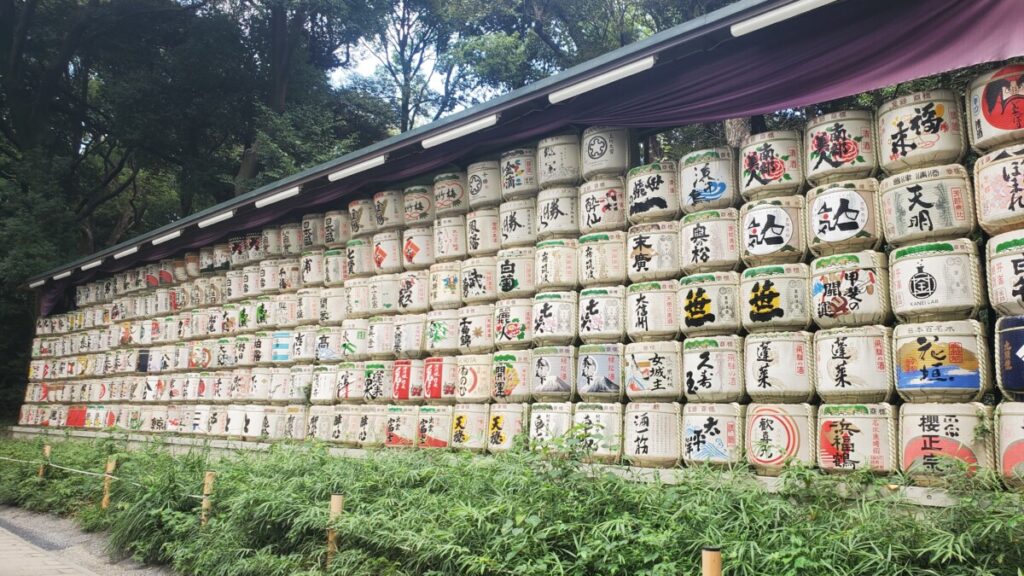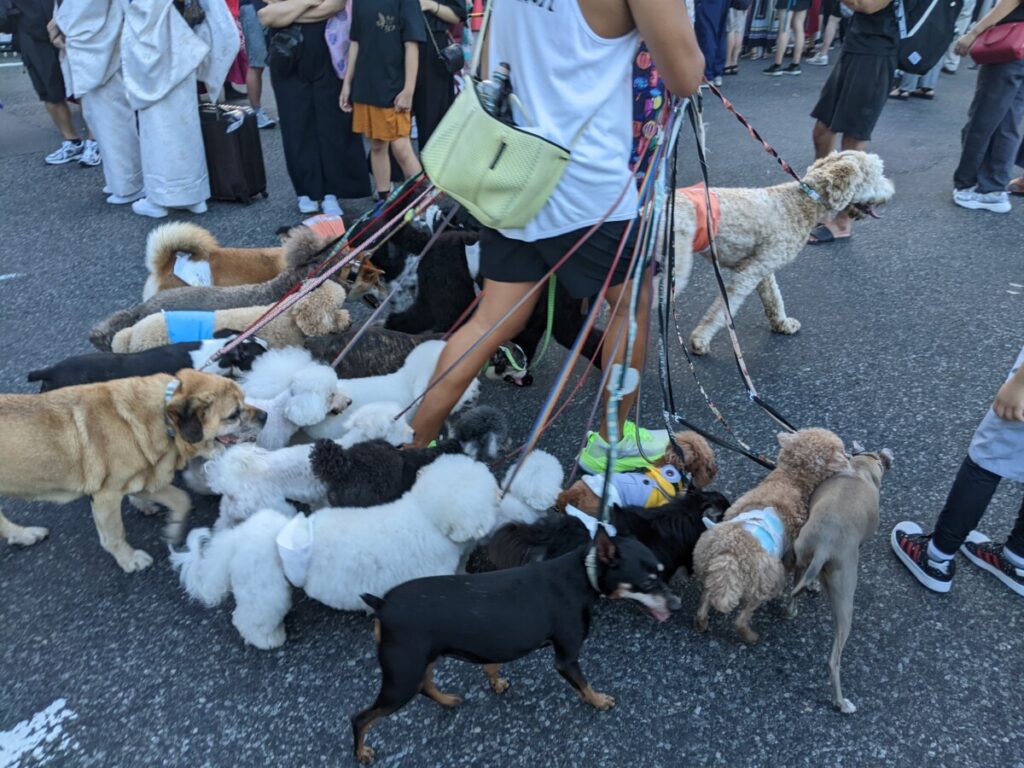Saturday morning was Leigh’s conference presentation, using her freshly rebuilt slides. I came out to watch, and as far as I could tell, it went over very well.
The conference would only last a half day, so I headed back to town with plans to meet Leigh later after she got done. Not wanting to get too far away, I spent the morning in the vicinity of Ikebukuro. The first thing I visited was a girls’ school designed by Frank Lloyd Wright. Unfortunately, there was some sort of event going on, so I couldn’t go inside, but it was still pretty neat.

Next, I wandered down to a lovely little neighborhood Japanese style garden park, which had a sternly worded sign out front. Google Translate informed me that a TURTLE had been found in the pond, and anyone caught dumping turtles in the pond would be in big trouble. Remember kids – when you go to Japan, don’t dump turtles. (Don’t do it anywhere, they’re a serious invasive species issue in a lot of places.)

Leigh messaged at that point that we would be having lunch with two of her undergrad students, who had made the trip all the way to Japan for the conference. I had read that the department store on the WEST side of Ikebukuro station had a nice food area, so I spent half an hour trying to locate the correct elevator to get to it.
I should mention – there’s two department stores in Ikebukuro station. The one on the west (西) side is called Tobu.(東武) The one on the east (東) side is Seibu. (西武) It is apparently an absolutely deceased equine to point out that the western store has the character for east in its name and vice versa. “Park on a driveway and drive on a parkway” level of eye-rolling “we know.”
We ended up not eating in that food area anyway.
After lunch, we went to see a dance festival that I had found an article about before we left. Called a Yokosoi, it’s an ancient style of dance that dates all the way back to (checks notes) 1954. Still, that’s getting pretty ancient at this point. And the dances were amazing.
Each group consisted of a large number (20-50 or so) dancers, a few people waving very large flags, and a hype man, who narrated and chanted along with the music. I’m pretty sure the actual term is not “hype man,” but I’m going with it. (Which is not to imply that this person was always male-presenting, as they absolutely were not.) The other defining feature of yokosoi is a small clapper called a naruko, which is always incorporated into the dance.
The groups ranged from reasonably good (including one delightful group that seemed to consist entirely of senior citizens) to absolutely spectacular, with phenomenal dance moves, costume quick changes, and flags the size of Luxembourg.

This one had two small children on stage for no apparent reason other than it was cute. Which it was.

The amazing thing is how MANY groups there were. Each performed for about three minutes, and then a minute later there was another one. For HOURS. Over two days and five stages.
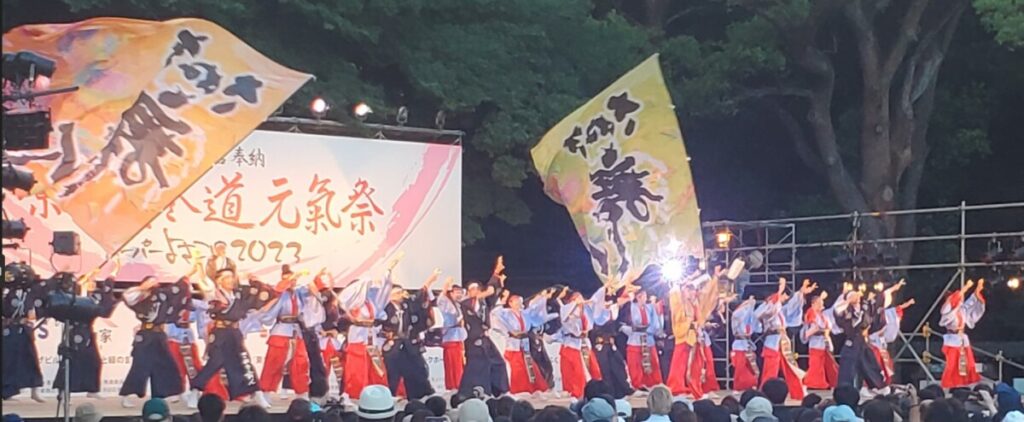
This stage was at the corner of Yoyogi park, a large park that contains the shrine to the Meiji emperor. In addition to legendary figures like Inari, shrines can also be constructed to memorialize specific people. The Meiji emperor was “restored” to power at the end of the Tokugawa Shogunate after the Americans showed up in the mid 1800s.
However, it’s important to note that what “restoring” the emperor actually meant was moving the real power from the shogun’s “advisors” to the emperor’s “advisors.” The emperor himself didn’t have any MORE power than he’d had for centuries, he was just being used as an excuse for replacing one faction with a different one.
It’s difficult to learn much about the actual PERSON of the Meiji emperor, but it’s pretty clear he had a serious alcohol problem, which made this massive display of sake barrels at his shrine somewhat ironic.
Irony or not, it did still feel somewhat awkward to take too many pictures of the shrine itself. Yes, EVERYONE was doing it, but the shrine was full of actual Japanese people, performing the rituals of veneration with apparent sincerity. Instead, here’s one of Leigh from just outside the shrine, sporting the latest in portable air conditioners.
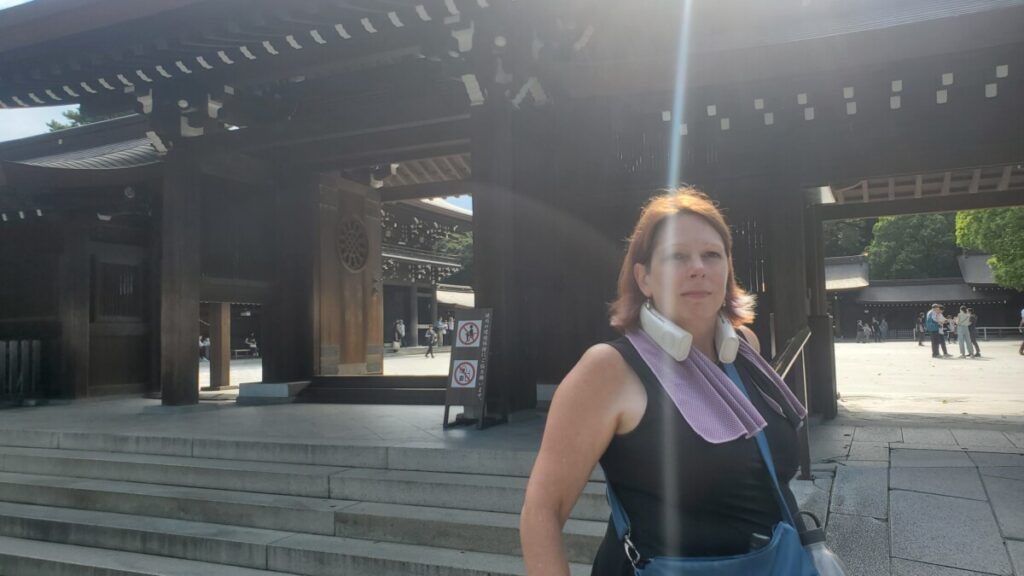
Seriously, we traded that thing back and forth all trip. It was an absolute godsend.
Moving from the sublime to the ridiculous, we walked back through the park to the bustle of the city again. In particular, Harajuku, which is known for being the center of cosplay / kawaii / youth culture in Tokyo.
Although it probably isn’t. From what I’ve read, it was the center twenty years ago, and now it’s the center of tourists taking pictures of other tourists looking for the center of youth culture. The main street is Takeshita Street, and we were NOT walking down there.

Nope. We wandered around a bit and looked at some other stuff. We found the shrine to Admiral Tōgō, who defeated the Russians in the Battle of Tsushima. It’s a very important story, which I am not going to go into here except to point out that this long form video about the “Voyage of the Damned” that the Russian fleet took to GET to its destruction at Tsushima is great.
We then realized we were right near a woodblock museum that I had thought about taking us to, but also that it was about to close. Shoulda gone straight there after the dancing.
Which was STILL going on, by the way.

We also so this guy trying to wrangle an absurd number of dogs.
However, at this point, we needed to leave to meet friends for one more quintessential Japanese experience – Karaoke!
We headed back up to Ikebukuro to a place called “Karaoke-kan”. No, not the one at 1 Chome-23-1 Nishiikebukuro, Toshima City, Tokyo. The identical one two blocks away at 1 Chome-25-1 Nishiikebukuro, Toshima City, Tokyo. Seriously, there are a LOT of karaoke places in Tokyo.
This was organized by one of Leigh’s fellow conference goers, and over the course of our two and a half hour slot, more and more people kept arriving. We started in a private room that held about ten people, and by the time it reached twenty or so, the staff realized they needed to move us to a larger room. There were two tablets that we could use to select songs and perform other functions, although given that the other functions were all in Japanese, we didn’t use those much.
As these were all goers to a music perception conference, the average performance level was perhaps somewhat higher than normal. Or not, who knows. I sang “Birdhouse in Your Soul.”
What the Karaoke place DIDN’T have was food other than small snacks, so after the singing broke up, Leigh and I went to a tiny, tiny gyoza place I had found online earlier.
How tiny, you ask?
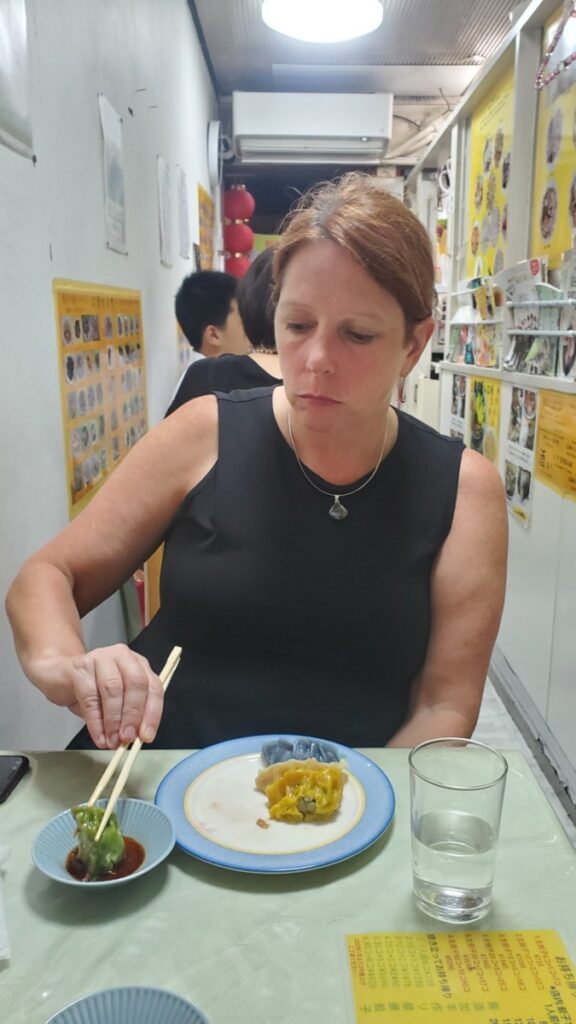
There were only six seats, three of which were occupied by the owner’s family. The dumplings were, unsurprisingly, fantastic. We even managed to deploy our terrible Chinese to say “Thank you” to the owner, who was from Taiwan.
My, that was a long day, wasn’t it?

